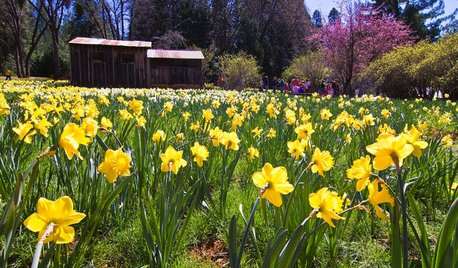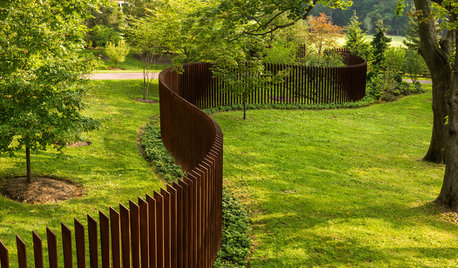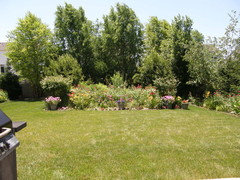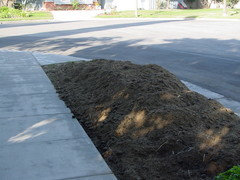Different NPK needs for different soil/climate
strawchicago z5
11 years ago
Featured Answer
Sort by:Oldest
Comments (24)
strawchicago z5
11 years agolast modified: 9 years agolola-lemon
11 years agolast modified: 9 years agoRelated Discussions
soil test questions (OM, N/P/K) from my Extension report
Comments (2)Optimum levels of organic matter in solils is btween 5 and 8 percent, so while not quite there you are getting close. Soil pH, for most plants, is in the 6.2 to 7.0 range, so while a bit low yours is okay. Nutrients you want in balance, not too much of one and too little of another which is where the problem lies. Nutrient imbalances create more problems then they solve. Nitrogen is dependant on soil warmth, bacterial activity. When soils are cool and there is little bacterial activity there is not much N available, but as soils warm, and the bacteria become more active more N is available to the plants. Nitrogen sources with readily available N, soluble types, can make it look like there is ample N in the soil but that will also wash out of the soil quickly with excess water and is the source of nitrate pollution of ground water....See MoreSoil for raised bed (different question)
Comments (6)I like Mel's mix, but even better for my rainy climate was mixing in with my existing clay soil to provide a bit of stability & moisture holding. Daily watering wasn't my style and soil was just a bit too loose for trellises not attached to wood boxes. We've been growing in our current boxes for 3 years and permanent beds without wooden sides for more than that. If you don't have boxes you probably won't want Mel's mix which is basically a container soil. Lasagna gardens might work better for you, too. Layering up is amazingly easy. Garden sides aren't necessary. Some climates do well with sunken gardens instead of raised. Used coffee grounds are free as is hay sweepings from the feed store. Inquire about bagging up what they sweep up after it spills when loading customer orders. I wear a mask, gloves, coveralls, & clean up after myself. Whatever the mix of hay & shavings is present always blends well as bottom layers of lasagna gardens we've built. Those gardens are loose & rich soils as compared to the "dirt" gardens. Amend as jolj suggested & your soil will be productive....See MoreGreat Ex. of the difference a micro-climate can make
Comments (12)I was afraid you would say that about the seeds! lol I do know of a place I can get a few of those palms and probably could order the others but they are rather expensive. Thats why I've held off. I think I can find some cheaper somewhere else. And unfortunately not yet. The only palm I have is my coco. The washy's that sprout up don't count. At the moment that space is mostly being taken up by large planters with many different types of aloes and other succulents. Ones I didn't take pictures of. @ bob in AZ Z9- Thanks! Yeah I would pick one up. They should do pretty good for you there as long as you water well. @ miketropic- I know right! lol But they sure do look nice when come back. Can't wait to get some fruit though :) They should be that age now. This spring/summer I shoud get a flower. They do flower and set fruit often here. This one isnt the most impressive I've seen here but I did manage to take a picture of this one up close. Thanks tropicalzone7!. They sure do. I just wish I was in the warmer part of town. lol What was the low that killed your majesty? - US_Marine...See MoreN-P-K differences
Comments (2)NPK values are NOT dependent on what you feed the worms and you won't be able to manipulate the end result, which is closer to humus than anything, rife with bacteria, which is what makes for a healthy soil - any type of compost can be high in various trace elements depending on the feedstock [some foods are high in boron for example, others high in sodium], but the NPK will always be pretty balanced in the range of 1-1-1 to 3-3-3, a soil amendment, not a fertilizer bacteria work on the nutrients of mixed organics - N for them is like protein for us, Carbon for them is like carbohydrates for us - enough of each and they breed and multiply - the worms 'slurp' the microbially rich decomposing surface layer of the material. and do a poor job of digesting the bacteria, leaving castings that contain much of what went in, including live bacteria, which continue the process .... eventually the worms and bacteria together break down all the material [continually re-ingesting the castings] to a very stable humus Bill...See Morestrawchicago z5
11 years agolast modified: 9 years agoUser
11 years agolast modified: 9 years agostrawchicago z5
11 years agolast modified: 9 years agoUser
11 years agolast modified: 9 years agostrawchicago z5
11 years agolast modified: 9 years agostrawchicago z5
11 years agolast modified: 9 years agoUser
11 years agolast modified: 9 years agostrawchicago z5
11 years agolast modified: 9 years agomichaelg
11 years agolast modified: 9 years agoUser
11 years agolast modified: 9 years agomichaelg
11 years agolast modified: 9 years agoroseblush1
11 years agolast modified: 9 years agomichaelg
11 years agolast modified: 9 years agoroseblush1
11 years agolast modified: 9 years agostrawchicago z5
11 years agolast modified: 9 years agofloridarosez9 Morgan
11 years agolast modified: 9 years agokittymoonbeam
11 years agolast modified: 9 years agostrawchicago z5
11 years agolast modified: 9 years agokittymoonbeam
11 years agolast modified: 9 years agojeannie2009
11 years agolast modified: 9 years agostrawchicago z5
11 years agolast modified: 9 years ago
Related Stories

GARDENING GUIDES7 Bulbs That Flourish in Mild Climates
Fall planting: For gardens that don't see harsh winters, different guidelines for choosing and planting spring-blooming bulbs apply
Full Story
FENCES AND GATES12 Delightfully Different Garden Walls and Fences
If pickets seem picked over and you shrink from chain link, try these full-of-personality fencing alternatives
Full Story
KITCHEN DESIGNKitchen of the Week: What a Difference Paint Can Make
A bold move gives a generic Portland kitchen personality without a major overhaul
Full Story
GARDENING GUIDESGrow a Beautiful Garden in Alkaline Soil
Got alkaline soil? Learn how to manage it and the many beautiful plants that will thrive in this ‘sweet’ soil
Full Story
GARDENING GUIDESHow to Stop Worrying and Start Loving Clay Soil
Clay has many more benefits than you might imagine
Full Story
GARDENING GUIDESGardening Solutions for Dry, Sandy Soils
Has your desert or beachy site withered your gardening creativity? Try these ideas for a beautiful, easy-care landscape
Full Story
GARDENING GUIDES6 Dependable Ground Covers for Warm Climates
Swap some lawn for these drought-tolerant clumping plants — and watch your maintenance efforts diminish while they easily grow
Full Story
GARDENING GUIDESGardening Solutions for Heavy Clay Soils
What’s a gardener to do with soil that’s easily compacted and has poor drainage? Find out here
Full Story
GARDENING GUIDESGet the Dirt on Your Garden’s Soil
Understand how your soil supports your plants so you can ensure your garden’s success
Full Story
GARDENING GUIDESHow to Pick a Mulch — and Why Your Soil Wants It
There's more to topdressing than shredded wood. Learn about mulch types, costs and design considerations here
Full StorySponsored
Franklin County's Preferred Architectural Firm | Best of Houzz Winner













strawchicago z5Original Author